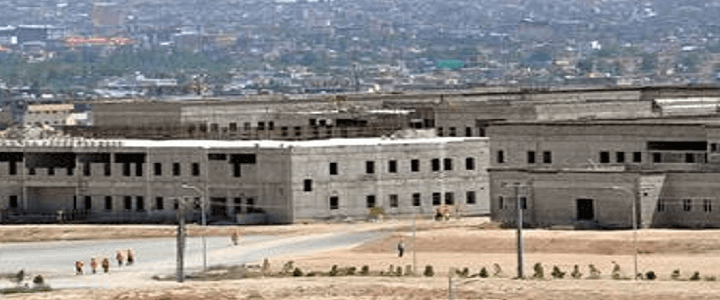Even the Taliban has leakers.
No one on the American side will formally confirm anything, but an anonymous Taliban official told the Associated Press over the weekend that an American delegation met with a Taliban delegation in Qatar. We know this principally because a Taliban “official,” did his best impression of a Washington insider and spoke to the AP on the condition of anonymity.
“The environment was positive and the discussion was useful, AP reporter Kathy Gannon quoted the Taliban official as saying. In a turn of phrase that will sound familiar to anyone familiar with the Washington parlor games, the official spoke to the AP on “condition of anonymity because he was not authorized to speak to the media.”
For its part, the State Department confirmed only that Alice Wells, the principal deputy assistant secretary of state for south and central Asian affairs, was in Qatar. No one, however, will talk on the record about what, beyond meeting the royal family, Wells and her team were doing there.
That, combined with the leak from the Taliban, says all we really need to know. The U.S. and Afghan governments are trying to work out a peace deal with the Taliban. And that’s okay.
The Taliban came to power for a reason
I deployed to Afghanistan twice in the space of two years as an Army Reserve Civil Affairs officer, first from October of 2002 to August of 2003, then from September 2004 to July of 2005. At the time, al Qaeda was the main enemy. The Northern Alliance, anti-Taliban Pashtuns, working with U.S. Marines and Special Forces, had beaten the Taliban into submission. But as it turns out, they had merely done what so many insurgents before had done: they melted back into the population and covertly plotted their reemergence.
And reemerge they did.
When I was in Afghanistan, the coalition’s main goal was to build a stable and secure country capable of sustaining and governing itself, which could provide sufficient internal security to ensure it could no longer serve as a base of operations for launching an attack against the American homeland. But as “stable” as the Afghan government might have become, the Taliban still represent a legitimate threat to the established order.
This is not entirely without reason. The Taliban initially rose to power in the aftermath of the Soviet occupation, and by early 1997 had, in the words of Pakistani journalist Ahmed Rashid, “brought relative peace and security to Kandahar and neighboring provinces,” and “galvanized Pashtun nationalism.”
Like Italy’s fascist Mussolini, they made the (metaphorical, in Afghanistan’s case) trains run on time. In the early days of Operation Enduring Freedom, local government workers criticized the Karzai government by complaining that “at least when the Taliban was in charge, we got paid.”
It is time for the U.S. government to acknowledge formally that any future for Afghanistan must by necessity involve the Taliban, as odious as they may be. The Taliban represent the most repressive, fundamentalist impulses of the Afghan people, but those views are still a legitimate representation of a significant segment of the that population. They did not rise to power by subjugating everyone.
When do we say “enough is enough?”
Negotiating a peaceful end to the war in Afghanistan is not an admission of defeat. We have prevailed militarily. But it may be time to admit that it is nearly impossible to completely defeat an insurgency like the Taliban. The movement grew out of the people, and for some, their brand of extreme Islam will always be appealing.
It is possible for the Taliban to become part of a political settlement. They would have to agree to end their armed struggle and compete on the battlefield of ideas, but the concept of bringing insurgents out of the hills and into government isn’t without merit.
Northern Ireland presents an example of the possibilities of reconciliation. Twenty years ago, former U.S. Senator George Mitchell chaired a delegation that negotiated the Good Friday Agreement, ending 30 years of “The Troubles.” Between 1968 and 1988, more than 3,600 people died in sectarian violence. The Good Friday Agreement was built on the understanding that it was time for the killing to stop, as neither the British government nor the Provisional Irish Republican Army would ever prevail outright.
The Rev. Ian Paisley, the Presbyterian minister who was a leader of the “Loyalist” faction in Northern Ireland, once said he was “not going to sit down with bloodthirsty monsters who have been killing and terrifying my people,” and said his largely Catholic nationalist opponents “breed like rabbits and multiply like vermin” agreed to share power with Martin McGuinness, who was, at the height of the violence the chief of staff of the Provisional IRA.
The two men not only shared power, they actually became good friends, proving that reconciliation is possible.
The sectarian distrust that provided the foundation of the unrest still exists in the North to a certain degree, and there have been several threats to the peace and the stability of the government. But despite those threats, Northern Ireland has become an economic powerhouse in the United Kingdom. It is a model for other conflicts.
I don’t harbor any delusions that Jeffersonian democracy will ever take root in Afghanistan. But that’s okay. A stable and secure government, which governs with the consent of the people and which takes the concerns of all of its citizens into account when formulating policy, is as good an outcome as I can imagine.
Do we have the political will to go down that road? It looks as if we may soon find out.




